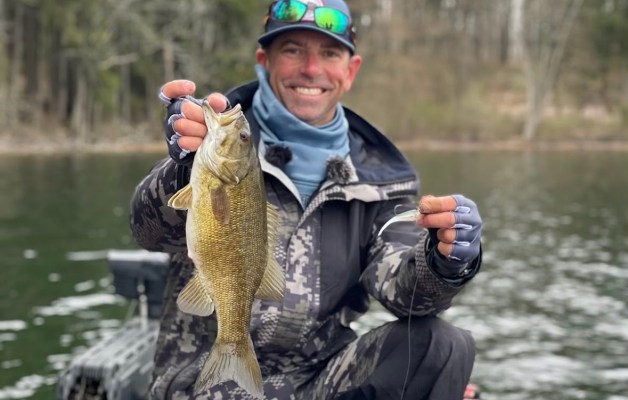Do it right and the fish is yours; do it wrong and the fish is nothing more than a "one that got away" story. We're talking about setting the hook, of course, and let's face it: Some anglers are better at it than others. Here's what three of the best have to say on the subject.
AARON MARTENS: FINESSE BAITS
Aaron Martens believes the most important thing in setting the hook with finesse baits is the rod. "I want a limber rod with a soft, parabolic (uniform) bend. That takes the shock out of the hook set and avoids breakage with light lines," he says.
If Martens' bait is hooked through the nose, or with the hook point exposed, he softly pulls the bait to make sure the fish is there before giving the rod a couple of sharp snaps. "Don't snap or jerk right away if it's (the bait) hooked through the nose. A lot of times they just grab the tail. If you don't jerk it away from them, they'll come back and bite again."
With other finesse baits, or when the hook point is buried in the plastic, he gives the bait a couple of sharp jerks right away and then begins the process of reeling and pulling.
His line — monofilament — is generally between 4- and 8-pound test. According to this successful angler, light line is not a problem if knots are tied correctly, the proper rod is used and the reel is equipped with a quality drag. "You'd be surprised how hard you can pull with 6-pound test. I've landed several 10-pounders on line that light," he relates.
Martens' Tip: Back-reel. A tight drag helps set the hook and back-reeling gives you more control over the fish.
DENNY BRAUER: JIGS
A big part of Denny Brauer's success as an angler is getting his jig bites to the boat. "A lot of times, in order to get hook penetration, you actually have to blow the head of that jig out between his teeth. Otherwise he'll just hold it in his mouth and then spit it out. I whack 'em!" he says.
Most of Brauer's jig fishing is with a 7 1/2-foot flipping stick. To help the rod do its job, he mounts a heavy, powerful reel on it and spools that reel with braided line. This makes for a complete system that allows him to set the hook and at the same time get the fish moving toward him and away from the cover.
Brauer believes the biggest mistake recreational bass anglers make when fishing a jig is that "as soon as they realize they have a bite, they rear back and pull. That's not a well defined, conditioned hook set."
Instead, Brauer recommends anglers take a few moments to reel out the slack in the line, drop the rod tip down and snap it back and up, straight over their heads so they develop the rod speed to pull the jig through the bass' teeth and drive the hook point into the jaw.
Brauer's Tip: Heavy cover = heavy line = heavy hook. Deep water = lighter line = thinner wire hook.
RICK CLUNN: CRANKBAITS
Rick Clunn is well-known for his ability to hook crankbait bass. Of late he's settled for a 7-foot heavy action rod with a fast tip for all of his fishing, including crankbaits. "I use a more aggressive hook set with my crankbaits than many anglers. I want the hook to penetrate, and I want enough power in the rod to control the fish after that."
Clunn fishes almost exclusively with monofilament line — 12-pound test or heavier most days — because he knows how it will perform and he doesn't believe in playing with a fish once it's hooked. "I set the hook hard and get the bass under control and to the boat. I only allow fish one uncontrolled moment in the fight. That's when I first bring it to the boat. After that I want total control."
He also modifies his crankbaits to help with his hook sets. "Round bend styles help hook the slappers — the ones hooked on the outside of the mouth. That's one reason I've been successful over the years. I hook almost all of my slappers. Most of the ones that get away are slappers that aren't hooked very well."
Clunn's Tip: Most rods made in Asian countries have lighter actions than what they say. A heavy is really a medium-heavy. Make sure your heavy is really heavy.
A GUIDE FOR HOOKING
LURE: Jig
ROD: 7 1/2-foot flipping strick
REEL: heavy
LINE: braid
HOOK:k heavy wire
CONDITIONS: heavy cover
HOOK SET: hard overhead jerk
LURE: Jig
ROD: 7 1/2-foot flipping stick
REEL: heavy
LINE: braid
HOOK: lighter wire
CONDITIONS: light cover/deep water
HOOK SET: hrd overhead jerk
LURE: Crankbait
ROD: 7-foot heavy fast tip
REEL: heavy
LINE: monofilament
HOOK: round bend treble
CONDITIONS: all
HOOK SET: aggressive (hard)
LURE: Finesse
ROD: soft (parabolic)
REEL: open-face spinning
LINE: mono-fluoro
HOOK: traditioal worm bend
CONDITIONS hook point exposed
HOOK SET gentle pull then sharp snap
LURE: Finesse
ROD: soft (parfabolic)
REEL: open-face spinning
LINE: mono/fluoro
HOOK: traditioal worm bend
CONDITIONS: hoodk point buried
HOOK SET: sharp snap




